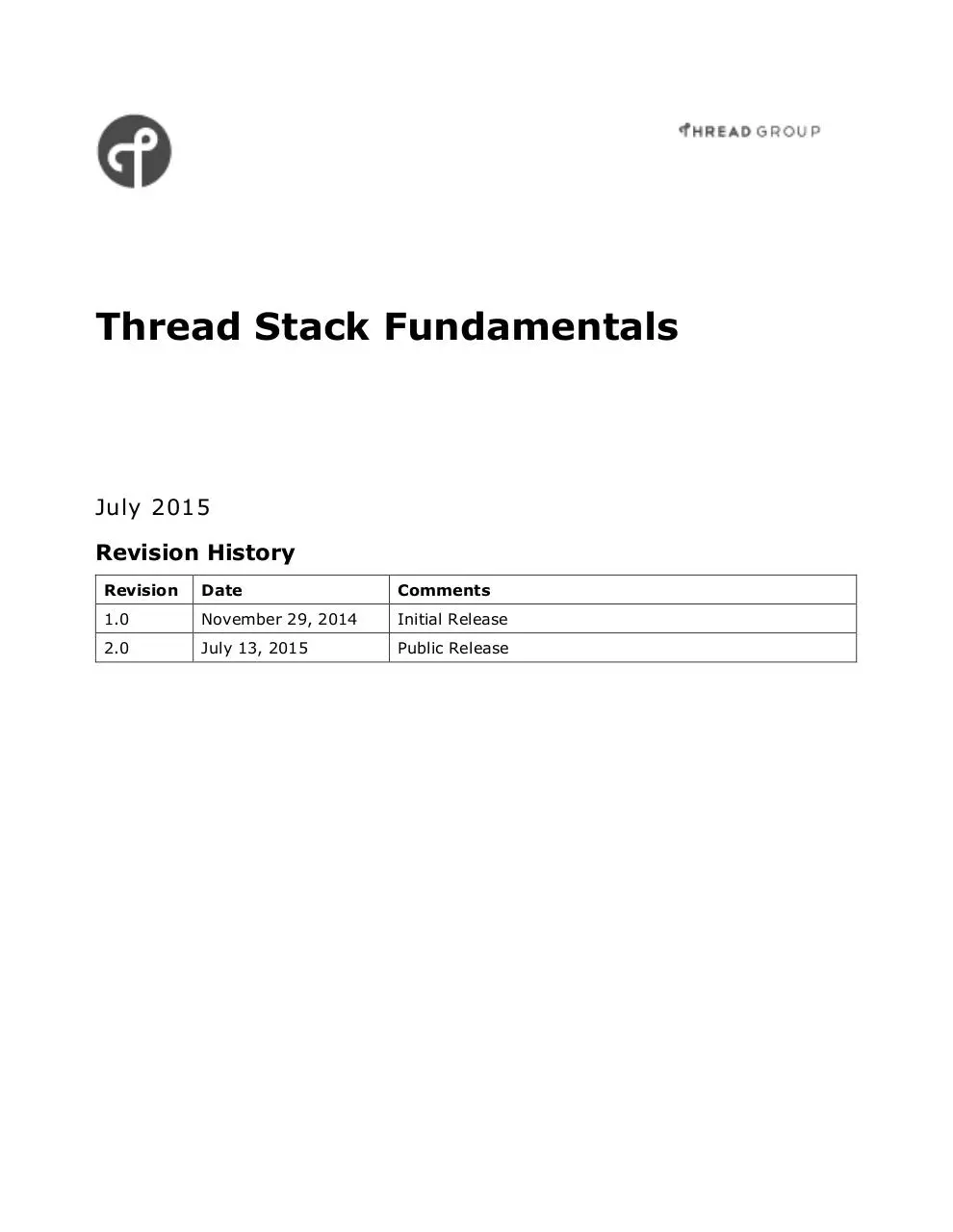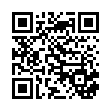Thread Stack Fundamentals v2 public (PDF)
File information
Title: Thread Stack Fundamentals white paper
Author: Thread Group, Inc.
This PDF 1.6 document has been generated by Acrobat PDFMaker 11 for Word / Adobe PDF Library 11.0, and has been sent on pdf-archive.com on 18/11/2015 at 15:21, from IP address 217.153.x.x.
The current document download page has been viewed 537 times.
File size: 299.01 KB (21 pages).
Privacy: public file





File preview
July 13, 2015
This Thread Technical white paper is provided for reference purposes only.
The full technical specification is available to Thread Group Members. To join and gain access,
please follow this link: http://threadgroup.org/Join.aspx.
If you are already a member, the full specification is available in the Thread Group
Portal: http://portal.threadgroup.org.
If there are questions or comments on these technical papers, please send them to
help@threadgroup.org.
This document and the information contained herein is provided on an “AS IS” basis and THE THREAD GROUP
DISCLAIMS ALL WARRANTIES EXPRESS OR IMPLIED, INCLUDING BUT NOT LIMITED TO (A) ANY WARRANTY
THAT THE USE OF THE INFORMATION HEREIN WILL NOT INFRINGE ANY RIGHTS OF THIRD PARTIES
(INCLUDING WITHOUT LIMITATION ANY INTELLECTUAL PROPERTY RIGHTS INCLUDING PATENT,
COPYRIGHT OR TRADEMARK RIGHTS) OR (B) ANY IMPLIED WARRANTIES OF MERCHANTABILITY, FITNESS
FOR A PARTICULAR PURPOSE, TITLE OR NONINFRINGEMENT.
IN NO EVENT WILL THE THREAD GROUP BE LIABLE FOR ANY LOSS OF PROFITS, LOSS OF BUSINESS, LOSS
OF USE OF DATA, INTERRUPTION OF BUSINESS, OR FOR ANY OTHER DIRECT, INDIRECT, SPECIAL OR
EXEMPLARY, INCIDENTAL, PUNITIVE OR CONSEQUENTIAL DAMAGES OF ANY KIND, IN CONTRACT OR IN
TORT, IN CONNECTION WITH THIS DOCUMENT OR THE INFORMATION CONTAINED HEREIN, EVEN IF
ADVISED OF THE POSSIBILITY OF SUCH LOSS OR DAMAGE.
Copyright 2015 Thread Group, Inc. All rights reserved.
Thread Stack Fundamentals
July 2015
Revision History
Revision
Date
Comments
1.0
November 29, 2014
Initial Release
2.0
July 13, 2015
Public Release
1
Contents
Introduction
................................................................................ 3
General Characteristics .......................................................................................... 3
IEEE 802.15.4 ...................................................................................................... 4
No Single Point of Failure ....................................................................................... 4
Device Types
................................................................................ 5
Border Routers ..................................................................................................... 5
Routers ................................................................................................................ 5
Router-eligible End Devices .................................................................................... 5
Sleepy End devices ................................................................................................ 6
IP Stack Fundamentals ..................................................................... 6
Addressing ........................................................................................................... 6
6LoWPAN ............................................................................................................. 7
ICMP
................................................................................................................. 7
UDP
................................................................................................................. 7
Network Topology ............................................................................. 8
Network Address and Devices ................................................................................. 8
Mesh Networks ..................................................................................................... 8
Routing and Network Connectivity .................................................... 9
MLE Messages....................................................................................................... 9
Route Discovery and Repair .................................................................................. 10
Routing .............................................................................................................. 14
Retries and Acknowledgements ............................................................................. 15
2
Joining a Thread Network ............................................................... 15
Discovery ........................................................................................................... 15
Commissioning ................................................................................................... 16
Attaching ........................................................................................................... 16
MLE Messages..................................................................................................... 17
DHCPv6 ............................................................................................................. 18
Management
ICMP
.............................................................................. 18
............................................................................................................... 18
Device Management ............................................................................................ 18
Persistent Data .............................................................................. 19
3
Introduction
General Characteristics
The Thread stack is an open standard for reliable, cost-effective, low-power, wireless D2D
(device-to-device) communication. It is designed specifically for Connected Home applications
where IP-based networking is desired and a variety of application layers can be used on the
stack.
These are the general characteristics of the Thread stack and network:
•
Simple network installation, start up and operation: The simple protocols for forming,
joining, and maintaining Thread Networks allow systems to self-configure and fix routing
problems as they occur.
•
Secure: Devices do not join the Thread Network unless authorized and all
communications are encrypted and secure.
•
Small and large networks: Home networks vary from several devices to hundreds of
devices communicating seamlessly. The network layer is designed to optimize the
network operation based on the expected use.
•
Range: Typical devices in conjunction with mesh networking provide sufficient range to
cover a normal home. Spread spectrum technology is used at the physical layer to
provide good immunity to interference.
•
No single point of failure: The stack is designed to provide secure and reliable operations
even with the failure or loss of individual devices.
•
Low power: Host devices can typically operate for several years on AA type batteries
using suitable duty cycles.
Figure 1 illustrates an overview of the Thread stack.
4
Figure 1. Overview of Thread Stack
IEEE 802.15.4
This standard is based on the IEEE 802.15.4 [IEEE802154] PHY (Physical) and MAC (Media
Access Control) layers operating at 250 kbps in the 2.4 GHz band. The IEEE 802.15.4-2006
version of the specification is used for the Thread stack.
The 802.15.4 MAC layer is used for basic message handling and congestion control. This MAC
layer includes a CSMA (Carrier Sense Multiple Access) mechanism for devices to listen for a clear
channel, as well as a link layer to handle retries and acknowledgement of messages for reliable
communications between adjacent devices. MAC layer encryption and integrity protection is
used on messages based on keys established and configured by the higher layers of the
software stack. The network layer builds on these underlying mechanisms to provide reliable
end-to-end communications in the network.
No Single Point of Failure
In a system comprised of devices running the Thread stack, none of these devices represents a
single point of failure. While there are a number of devices in the system that perform special
functions, the design of the Thread stack is such that they can be replaced without impacting
5
the ongoing communication within the Thread Network. For example, a sleepy Child requires a
Parent for communications so this Parent represents a single point of failure for its
communications. However, the sleepy device can and will select another Parent if its Parent is
unavailable so this transition should not be visible to the user.
While the system is designed for no single point of failure, under certain topologies there will be
individual devices that do not have backup capabilities. For example, in a system with a single
gateway, if the gateway loses power, there is no means to switch to an alternative gateway.
A Router or Border Router can assume a Leader role for certain functions in the Thread Network.
This Leader is required to make decisions within the network. For example, the Leader assigns
Router addresses and allows new Router requests. The Leader role is elected and if the Leader
fails, another Router or Border Router assumes the Leader role. It is this autonomous operation
that ensures there is no single point of failure.
Device Types
Border Routers
A Border Router is a specific type of Router that provides connectivity from the 802.15.4
network to adjacent networks on other physical layers (for example, Wi-Fi and Ethernet). Border
Routers provide services for devices within the 802.15.4 network, including routing services for
off-network operations. There may be one or more Border Routers in a Thread Network.
Routers
Routers provide routing services to network devices. Routers also provide joining and security
services for devices trying to join the network. Routers are not designed to sleep. Routers can
downgrade their functionality and become REEDs (Router-eligible End Devices).
Router-eligible End Devices
REEDs have the capability to become Routers but due to the network topology or conditions
these devices are not acting as Routers. These devices do not generally forward messages or
provide joining or security services for other devices in the Thread Network. The Thread Network
manages REEDs becoming Routers if necessary without user interaction.
6
Sleepy End devices
Sleepy end devices are host devices. They communicate only through their Parent Router and
cannot forward messages for other devices.
IP Stack Fundamentals
Addressing
Devices in the Thread stack support IPv6 addressing architecture specified in [RFC 4291].
Devices configure 1 or more ULA (Unique Local Address) or GUA (Global Unicast Address)
addresses.
The device starting the network picks a /64 prefix that is then used throughout the Thread
Network. The prefix is a Locally Assigned Global ID, often known as a ULA prefix [RFC 4193],
and can be referred to as the mesh local ULA prefix. The Thread Network may also have one or
more Border Routers that each may or may not have a prefix that can then be used to generate
additional GUAs. The device in the Thread Network uses its Extended MAC address to derive its
interface identifier as defined in section 6 of [RFC 4944] and from this configures a link local
IPv6 address with the well-known local prefix FE80::0/64 as described in [RFC 4862] and
[RFC 4944].
The devices also support appropriate multicast addresses. This includes link-local all node
multicast, link-local all-router multicast, and realm-local multicast.
Each device joining the Thread Network is assigned a 16-bit short address as specified in
[IEEE802154]. For Routers, this address is assigned using the high bits in the address field with
the lower bits set to 0, indicating a Router address. Children are then allocated a 16-bit short
address using their Parent’s high bits and the appropriate lower bits for their address. This
allows any other device in the Thread Network to understand the Child’s routing location simply
by using the high bits of its address field.
Figure 2 illustrates the Thread short address.
7
router_id
child_id
u16
Figure 2. Thread Short Address
6LoWPAN
All devices use 6LoWPAN as defined in [RFC 4944] and [RFC 6282].
Header compression is used within the Thread Network and devices transmitting messages
compress the IPv6 header as much as possible to minimize the size of the transmitted packet.
The mesh header is supported for more efficient compression of messages within the mesh and
for link layer forwarding as discussed in the Routing and Network Connectivity section. The
mesh header also allows end-to-end fragmentation of messages rather than hop by hop
fragmentation specified in [RFC 4944]. The Thread stack uses route-over configuration.
The devices do not support neighbor discovery as specified in [RFC 6775] as DHCPv6 is used to
allocate addresses to Routers. End devices and REEDs are allocated short addresses by their
Router Parent. This short address is then used to configure the mesh local ULA that is used for
intra-network communications.
Further details on 6LoWPAN usage and configuration are contained in the “Thread Usage of
6LoWPAN” white paper. Chapter 3 of the Thread specification details the specific 6LoWPAN
configuration used.
ICMP
Devices support the ICMPv6 (Internet Control Message Protocol version 6) protocol [RFC 4443]
and ICMPv6 error messages, as well as the echo request and echo reply messages.
UDP
The Thread stack supports UDP (User Datagram Protocol) as defined in [RFC 768] for messaging
between devices.
Download Thread Stack Fundamentals v2 public
Thread Stack Fundamentals_v2_public.pdf (PDF, 299.01 KB)
Download PDF
Share this file on social networks
Link to this page
Permanent link
Use the permanent link to the download page to share your document on Facebook, Twitter, LinkedIn, or directly with a contact by e-Mail, Messenger, Whatsapp, Line..
Short link
Use the short link to share your document on Twitter or by text message (SMS)
HTML Code
Copy the following HTML code to share your document on a Website or Blog
QR Code to this page

This file has been shared publicly by a user of PDF Archive.
Document ID: 0000315746.